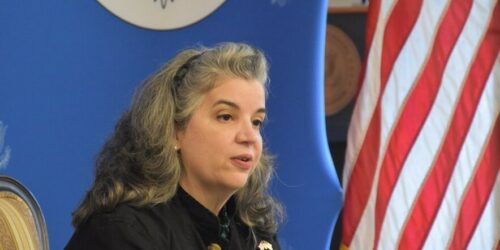When Chao Tayiana was growing up in Ngong town, west of Nairobi, she heard many stories about the Tsavo man-eaters, a pair of lions that “terrorised” and killed African and Indian railway workers during the construction of the Kenya-Uganda railway in the late 1800s – and were later “heroically” shot by John Patterson, a British officer.
The man-eating big cats lent drama to the romanticised view of railways as a way for Europeans to penetrate “the deep dark interiors of Africa”, or as a symbol of Britain’s grand designs for development of the “wild” African continent. The photo of Patterson posing with one of the dead lions became synonymous with white conquest.
The railway, which was built by the British as a way to gain control over the source of the Nile, Lake Victoria in Uganda, had broader implications for the UK’s trade relations with Europe and the rest of the world; and the mainstream narratives about it had been told from a western perspective. Tayiana’s school history lessons were little different, and it didn’t occur to her at the time to question these accounts.
But when she was in her early 20s she realised a “different kind of story needed to be told”. At university, while she was studying computer science, she started a history blog for fun – and received dozens of messages from Kenyans across the country and in the diaspora in response to a post she wrote about the birth of Nairobi.
Around the same time, on one of her regular visits to the national archives in Nairobi, she spotted an unusual reference among the standard reports. It suggested that among some communities, there was a belief that the Tsavo lions were the spirits of dead chiefs who were resistant to the construction of the railway.
Intrigued by this interpretation of events Tayiana was keen to find out what the railway had meant to other Kenyans who lived around the stations, or worked in them, and decided to investigate. Over the next four years, she visited more than 55 stations across the country, taking photos and speaking to people, in a project she would later call Save the Railway.
“As I went along, I was making all these connections that I hadn’t made in school,” she says. She found out, for instance, that many railway lines began or ended in areas with white settler populations – an indication, she believes, that Africans were not its target market. Some people she met remembered the railway favourably, describing how they’d used it to get to school, work, or to bury their dead – but others recalled how it had alienated their community lands. Tayiana documented the information and photos she gathered on the Save the Railway website, which is now one of the most detailed and accessible archives on the old stations.
The project was a pivotal moment for Tayiana, validating her sense of history “as a living thing” – something she’d learned at an early age through the stories her maternal grandparents told her and the old books, photos, magazines and ornaments they shared – and changing the way she perceived her role as a historian.
“There is a huge injustice in remembering yourself through the lens of someone else,” she says. “Our history was something that we were ‘told’, it was never something we did or contributed to. Save the Railway was that eureka moment – it was that big realisation for me that I am an active contributor to the formation and understanding of our history.”
After completing her degree, Tayiana did a master’s in heritage visualisation and documentation at Glasgow School of Art where, she says, she “found the language and technique” for what she was already doing in Kenya, where the digitisation of cultural heritage is still in its early stages.
In 2018, she co-founded the Museum of British Colonialism, a volunteer collective calling for “a more truthful account of British colonialism”.
The museum – which does not have any artefacts or physical presence – is meant to shatter the conventional ideas and symbolism of bricks and mortar spaces. An online archive, it features reconstructions of concentration camps where British soldiers held about 1.5 million Kenyans suspected of being part of the Mau Mau rebellion, an anti-colonial uprising, committing widespread atrocities against them, including torture and rape. The colonial administration was later found to have destroyed or concealed many of those records, and Kenya’s first post-colonial government chose to implement a “forgive and forget” policy.
“I go to these towns and I’d have never known there was a detention camp there,” she says. “How is it possible that they can just vanish off a country’s landscape … in a nation that went through unspeakable, gruesome acts in the fight for its independence?”
Tayiana is also co-founder of Open Restitution Africa, an initiative that maps data on the return of African treasures that were seized or stolen by former colonial powers, and documents the demands for these artefacts. Information around restitution was siloed, she says, and its “progress and complexities couched from the perspective of the west”.
Nearly 10 years on from the railway project, Tayiana’s approach to Kenyan and African history is making waves. This year she was awarded the Dan David prize for her work in centering African stories within the digital space at a time when “many African and Afro-diasporic audiences are looking to reclaim their past and take back agency over their identities”.
Through African Digital Heritage, a non-profit she created in 2019, she works with museums to reimagine how they preserve and digitise African history and culture. Museums, she says, traditionally existed to cater to white intrigue rather than for Africans to understand their history.
“You have taken history and separated it from people – everything is in glass cases with scant information – how are people supposed to engage? African museums should be about repair, they should focus on generating dialogue.”
While she may be gaining recognition, being a digital heritage pioneer in Kenya has meant that her work was often undermined, and she has little financial support for her groundbreaking research. Despite the struggles, Tayiana, who describes herself as a “headstrong historian”, would do it all again.
“I want my grandchildren to find their answers in my work,” she says. Beyond that, she sees her work resonating with Kenyans now.
“The resounding comment I get is – why didn’t we learn this at school?” says Tayiana. “It’s a kind of recognition to hear people say – ‘this is so important, why were we denied access to this information?”
Source: The Guardian






